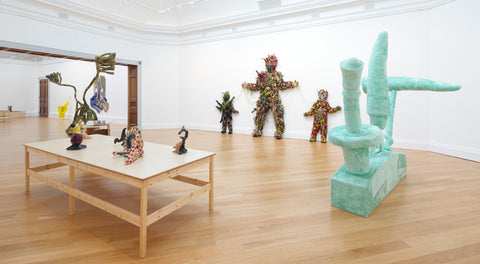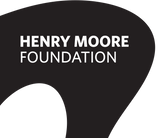Meet the Curators – Olivia Bax and Sam Cornish

Our current exhibition These Mad Hybrids: John Hoyland and Contemporary Sculpture has opened to rave reviews!
It has been described as a ‘rich and playful show’ and the perfect ‘space to reflect on the liberating potential of sculptural hybridity and the creative interconnection between two- and three-dimensional practice’.

Photo Credit: Lisa Whiting
But who masterminded the show? Meet the wonderful co-curators of These Mad Hybrids, Olivia Bax, who also has artwork in the exhibition, and Sam Cornish of the John Hoyland Estate. We asked Olivia and Sam some questions about their careers, their experience of curating this exhibition and their connections to the late artist John Hoyland RA, whose ceramics inspired the project. Here is what they had to say...
Q. Olivia, Can you tell us about your creative background and artistic career so far?
A. I have been interested in art for as long as I can remember; I moved to London from Scotland to do a Foundation at Wimbledon School of Art because I was interested in set design. My set was unpractically large, and it was suggested to me that I might be a sculptor! From there I went to Byam Shaw School of Art. After my BA, I worked as a studio assistant to Anthony Caro. Following his death, I obtained a postgraduate degree from the Slade School of Fine Art. I have been fortunate enough to work with some supportive galleries in the UK and internationally. There is nothing better than being in the studio.

Olivia Bax in the studio, Photo: Jean-Philippe Dordolo
Q. What inspires you as an artist?
A. The list is long! I take inspiration from things around me. I draw, visit galleries and museums, read, go to the theatre, watch films etc. Last year I went to Rome and am still processing a lot of the architectural encounters. I have artist friends both in the studio complex where I work and through the University of Gloucestershire where I lecture. The conversation between artists is rich, stimulating and encouraging.

Olivia Bax’s studio, preparing sculptures for Cavalcade, BoLee and Workman, Bruton
Q. Sam, what is your background and how has your career developed?
A. I'm from and still live in south London. Although I don't have a family background in art, I studied art history at Cambridge and Leeds. For some time now I've been interested in abstract painting and sculpture, writing and curating exhibitions. I recently curated a show of Mali Morris's paintings at the IKON, Birmingham. My next two curatorial projects are both sculpture exhibitions: a show of Garth Evans's sculpture at the CALOSA foundation, Mexico in May, and then in June, a show of Tim Scott's sculpture at the APT Gallery in London. Both Evans and Scott made significant contributions to British art in the second half of the twentieth century, and are both overlooked.

Sam Cornish at These Mad Hybrids Private View, Photo: Alice Hendy
Q. How did you each come to know the work of John Hoyland and when did your relationship with the Hoyland Estate begin?
A. (Sam) My interest in abstract art, specifically that made by artists of roughly Hoyland's generation, began, or at least was seriously developed, at Poussin Gallery, where I worked with Robin Greenwood on and off between 2005 and 2012. Sadly Robin died last year. I'd love Robin's sculpture to get a serious showing. I started to work part-time with Beverley Heath-Hoyland at The John Hoyland Estate in about 2015. I've been developing exhibition projects and working on the catalogue raisonne, which I co-edit with Wiz Patterson Kelly. If anyone out there has an uncatalogued Hoyland painting, please get in touch!
(Olivia) I have known Wiz Patterson Kelly who works for the Hoyland Estate ever since I started as a studio assistant to Caro in 2010. Wiz had been working in the office for several years. Sam became a friend after taking an interest in my practice from an early stage. Following my Mark Tanner Sculpture Award exhibition at Standpoint Gallery in London in 2020, Sam invited me to see Hoyland’s ceramics because he could see a relationship between the ceramics and my sculptures. Like most people, I didn’t know Hoyland had made sculpture. I was struck by the work: they are odd, playful, awkward and funny.

Photo: Tim Bowditch
Q. Can you tell us a little about the process of curating this exhibition, from conception to realisation?
A. (Olivia) After I visited Hoyland’s studio Sam, Wiz and I started discussing the ceramic’s relationship to contemporary sculpture. We had the germ of an idea for a show but needed a venue and money to make it happen. Fortunately, the University of Gloucestershire had an established connection with the RWA and both the University and the Museum were willing to endorse and support the exhibition.
(Sam) Hoyland called the ceramics "these mad little hybrids" and emphasised their freedom, their colour and the "humour or even irony" he felt able to imbue them with. All these qualities were on our minds as we made the selection. Early on we ruled out including other work in ceramics, as well as steel sculpture, a material used by many of Hoyland's contemporaries. We bounced ideas around of artists and art-works. It was a fun and surprisingly friction-free process. I think we quite quickly realised broadly what we were looking for, although it took some time to get to the final selection of artists and artworks. We wanted both harmony and dissonance between the works. The sculptures needed to relate to each other, but with enough of an antagonistic edge to keep things lively
Q. Sam, were there any bumps along the way?
A. There were a few artists we approached whose work was not available for the show. I guess this is normal for a display of this size. Frustrating at the time, but when it went up we didn't feel their absence at all. There was also a brief moment when it looked like Andrew Sabin's From Time to Time might not fit up the RWA's stairs, but the great technicians at the gallery found a way!

Photo: Tim Bowditch
Q. Olivia, do you have a favourite work in the exhibition?
A. I can’t pick one! Caroline Achaintre’s giant woollen sculpture painting; Eric Bainbridge’s hilarious monumental fur sculpture; Phyllida Barlow’s juicy mini Barlow installation; Hoyland’s mad ceramics; Anna Reading’s gritty bird; Jessi Reaves’ inside-out sculpture; Andrew Sabin’s giant-insect-meets-plant-walking-pastry straddling two exhibition spaces; John Summers’ enigmatic figures and their relationship with the classical frieze at the RWA and Chiffon Thomas’ (very first outing in Europe) unravelling sandwich face. The exhibition has it all.
Q. How do you both feel now that the exhibition is open?
A. (Sam) Given the diverse sculptures we are showing, it was hard (for me at least) to completely envision what would happen when the works were all sharing the same space, and what conversations they would have with one another. I would say it was the most unpredictable show I've worked on. But it was thrilling seeing it all come together. I hope the visitors can share some of that surprise and that excitement...
(Olivia) Amazing! It has been so rewarding to see it in place after so much discussion and effort. Of course, I am biased, but I think it is the best exhibition of sculpture I have ever seen.
Q. Olivia, What are you most excited about going forward, both in your curatorial career and your artistic progression?
A. I have a solo show on just now at Holtermann Fine Art in London. I wrote a short story to accompany the exhibition from the perspective of a transport dolly. This project has given me the confidence to inject more humour into all aspects of my practice. The exhibition at Holtermann runs till 16 March. On 9 March, I am opening a solo show with BoLee and Workman in Bruton. The space is in an old Methodist Chapel, so the sculptures can occupy both the upper choir and lower floor. I have been making these sculptures for some time – and I am looking forward to seeing the work occupy two different levels.
Curatorially, I have been talking to my painter friend James Fisher about ideas around Camouflage. I can’t say much more about the project just now because it’s still lurking and not fully revealed.
Q. Finally, Sam, What does the future look like for the Hoyland Estate?
A. We've been really excited about the response to the ceramics so far, especially from people not familiar with his work. In the future, we are planning to showcase other moments of his career, whether looking at more well-known works with fresh eyes or bringing lesser-known periods into light. I'd love to do a show of Hoyland's paintings from the 1990s. I know Paul Hedge of Hales Gallery is interested in Hoyland as a working-class figure, and as a painter who engaged with urban experience. There any many threads that could be developed. And Hoyland still needs a fully comprehensive retrospective exhibition...
Come and see the exhibition for yourself
These Mad Hybrids: John Hoyland and Contemporary Sculpture | 03 February - 12 May 2024 | From FREE - £16
Join Olivia and Sam, along with a panel of artists and writers for an In Conversation event on 21 March 2024, to celebrate the launch of These Mad Hybrids, The Book!
This exhibition has been made possible by the kind support of:

